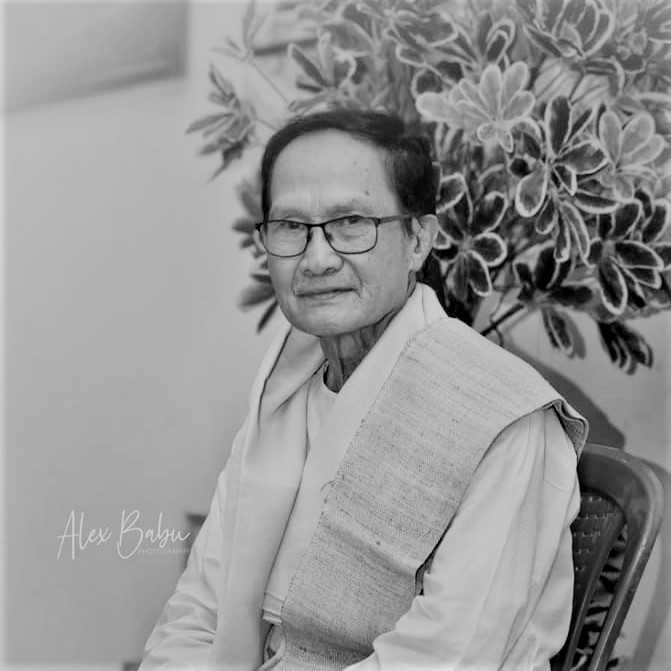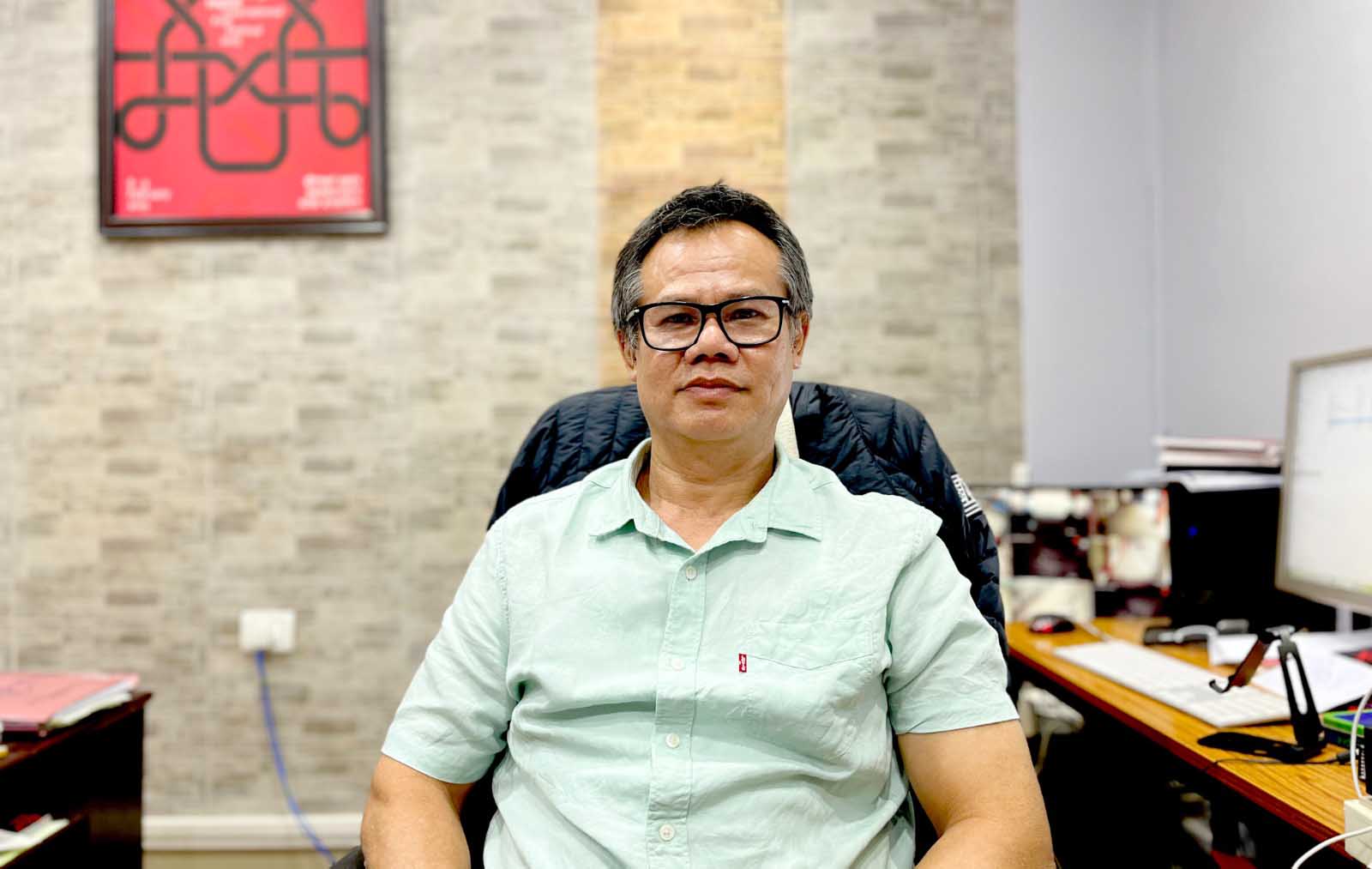On the other hand, Th. Tombi Singh is also a renowned artist and a teacher. He has met with success in both. But there is a difference between the two. Teaching opened the door not only to his family’s livelihood but also to a service in the cause of education in his choice of profession. Still, painting is the most important thing in his life that has become a sole mission to which he has dedicated his whole life. He cannot distance himself from this art. So, he dedicated the rest of the time he could avail himself to painting. He did not ever neglect his duties as a teacher. Nevertheless he pledged himself into hectic activity to promote the arts proactively.
He joined a private college called Imphal College as a lecturer in Political Science in 1963 just after passing M.A. from Poona University in the same year. The monthly salary at that time was about Rs. 340/-only. Later his college was taken over by the Government of Manipur. Th. Tombi retired in 1999 as a Principal of this same college.
The life style of the students in those days was much different from what we see today. Having passed the Matriculation Examination in 1956 he got admitted in the prestigious D.M. College of Imphal. In those days, students using bicycles were a rare sight. Most of them used to walk. Th. Tombi also walked the long distance from Khagempalli to D.M. College wearing half-pants. Students gave sincere respect to their teachers and revered them much. He still remembers those days with a warn glow in his heart. Then came the days of Poona University – a new strange place, his first time outside Manipur, a big city, strange people, strange life. His mental outlook expanded like a blooming flower. He cannot forget his University days easily.
Th. Tombi, the artist was never a dull student. He paid equal interest in other activities too besides his studies. He was a badminton player and also plays the flute quite well. Among his hobbies the play of flute occupies an interesting niche. Because he earlier learnt the art satisfactorily from a teacher late Shri R.K. Sanahal Singh of Thangjam Leirak, Imphal during his high school days. As there was not much dissatisfaction in the form of tapes and loud speakers blaring musical and songs of all sorts, almost all the localides lived in blissful peace. Motor vehicles too did not ply that frequently. So, youths used to play the flute to their heart’s content as they roamed. Life was not too much complicated. There was a hillock called Chinga conveniently situated a short distance from his house where he used to play and practise the flute. He is an adopt also in playing toudri – a sort of pipe which was much in vogue those days. So, Tombi performed the flute before audience while studying in Poona and Baroda. He plays the sitar too which he learnt from the sitar maestro of Manipur – Oja Thambou Singh and Oja Brajabidhu Singh. The artist Th. Tombi is thus, an unknown musician. The sense of music that flows through his mind found expression in the rhythmic representation in his works. The stylisation which we find in his paintings is manifestation of the rhythmic pattern that he had acquired early in life.
Next, an unforgettable event for Th. Tombi is his days of discipleship in the M.S. University of Baroda during 1975-77 where he met his second guru Prof. K.G. Subramanyan. It also proved a turning point in his career as a painter and the experience became the harbinger of a new phase in his approach to painting. The journey to Baroda was also struggle in the beginning. It may be elucidated with a slight diversion.
The Manipur State Kala Akademi (MSKA), the foremost institution working for the growth and rejuvenation of Manipuri art and culture was established in 1972 with the renowned poet-scholar E. Nilakanta Singh as the Secretary. Art Exhibitions, art workshops, memorial lectures also became a regular feature of the MSKA and Shri Nilakanta used to invite famous painters such as K.K. Hebber, K.G. Subramanyan, Chintamani Kar, G.R. Santosh, A. Ramachandra, Jatin Das, R.S. Bists, etc. to these occasions. Th. Tombi bagged the prestigious awards of the MSKA twice in 1974 and 1976. Shri K.K. Hebber suggested to E. Nilakanta that Th. Tombi be sent to Baroda for studying the art of painting especially as he thought Tombi’s use of bold form and colour suit his study in that University. But Th. Tombi’s was serving in a private college teaching political science and was thus not entitled to avail government deputation. At this critical moment E. Nilakanta, the Secretary and H. Ranbir, the then Education Secretary to the Government of Manipur came out to be his saviour. With their help room was made for a talented young artist for studies in Baroda. He is much indebted to them in this regard.
Life in Baroda brought great changes in him. A new open sky expanded before him – inhibition whatever there might be in him left as swirls of smoke that climb and disappear in the blue expanse. He became free – free as a bird suddenly set loose and started enjoying as it were, a free fall that is so important in an artist.
The M.S. University of Baroda is one of the famous study centres of contemporary art in India. Prof. K.G. Subramanyan who is the guiding spirit is not only an thst hunself but also a scholar of repute with many books on art criticism to his credit. ln this place and at Bombay Th. Tombi had the great opportunity to meet not only Prof. K.G. Subramanyan but also such great souls like K.K. Hebbar, Jeram Patel, Jyoti Bhatt, Mahendra Pandya, Gulam Md. Sheikh, M.S. Bemdre, Gautam Vaghela, etc. in person. Here art exhibitions are organized frequently. Many other renowned artists also pay visits to this University all the year round. The students are left to their own sweet will. There is not much restriction in many respects. Students of both sexes mix freely. On Sundays the art students visit the market places and do sketches of the scenes before them. Baroda provides live models also which proved to be an exciting first experience for the artist. Again the students made study tours to such famous places as Ajanta, Ellora, Helibid, Bellur, the Elephanta Caves, Konark, Khajuraho etc. to name a few. These became art centres for them when they studied the temple sculptures and drew them. Baroda was a real artists’ paradise for Th. Tombi. And all those priceless works by those unknown great masters enticed Tombi’s ever yearning heart. He did sketches to his heart’s content lying before those silent treasures of the past. His heart, mind, his whole being got a new life – his outlook became fresh like the morning rose and it seemed, a world of active communion with the realm of art was opening its wide arms for him. The best part of his life during his early days was spent in Baroda.
The aftermath of his days in Baroda as a student of art saw great changes in Tombi’s style and technique. It also ushered in a new pictorial language in him which found expression in distorting the pedagogue academicism. The credit for such a great change also goes to his great guru Prof. K.G. Subramanyan. He understood Tombi’s sensibility and the inherent artistic creative impulse running through his being – like a father knows his son. He inspired Tombi to further explore his original style of painting. So, he consistantly said, “Tombi, don’t pay heed to all the different styles prevailing here. Make a return to the style you left in Manipur.” The underlying meaning clearly insinuates that Tombi should maintain his identity and pursue to achieve the goal. Prof. K.G. Subramanyan did not like Tombi to be carried away by other styles and lose his originality. His works gave a strong impetus and encouragement to Th. Tombi. In 1977, Tombi gave a solo exhibition of his paintings in Baroda consisting of about twenty paintings and drawing which he did during his visit to those important art centres mentioned above and also those of the market scenes. His works were much applauded.
Tombis’s realistic paintings saw a definite close by 1954. From this time onwards he had progressed towards painting subjectivity, following his own impulse and discarding academic regulations to a great extent. In fact his last realistic painting is a landscape with details which he did way back in 1954. He was eighteen and a final year student in the Imphal Art School. Afterwards he started concentrating on themes related to social realism. “Fisher Women” (early ’70s) was one such painting. Baroda now gave him under the able guidance of his guru the determination to follow his heart and to return to his pre-occupation with his original intent of seeking his own identity and milleu. At present he is making use of this style.











